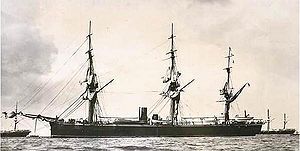HMS Rover (1874)
 HMS Rover | |
| Career (United Kingdom) | |
|---|---|
| Name: | HMS Rover |
| Builder: | Thames Ironworks and Shipbuilding Company, Leamouth, London |
| Laid down: | 1872 |
| Launched: | 12 August 1874 |
| Completed: | By 21 September 1875 |
| Fate: | Sold for scrap in 1893 |
| General characteristics | |
| Class and type: | Iron screw corvette |
| Displacement: | 3,462 tons |
| Length: | 208 ft (63.4 m) pp |
| Beam: | 43 ft 6 in (13.3 m) |
| Draught: |
17 ft 6 in (5.33 m) (forward) 22 ft 7 in (6.88 m) (aft) |
| Depth of hold: | 23 ft (7.01 m) |
| Propulsion: |
3-cyl. horizontal compound expansion 10 cylindrical boilers Single (hoisting) screw 4,964 ihp |
| Speed: |
14.5 knots (27 km/h) Under sail 11 knots (20 km/h) |
| Range: | 1,840 miles 10 knots (19 km/h) with 420 tons of coal |
| Complement: | 315 |
| Armament: |
As built
From 1879-80
|
HMS Rover was an 18-gun iron screw corvette of the Royal Navy. She was built by the Thames Ironworks and Shipbuilding Company, Leamouth, London to a design by Edward James Reed and launched in 1874.
Design and construction
Rover was the result of an 1872 design by Edward James Reed, she was laid down at the yards of the Thames Ironworks and Shipbuilding Company at Leamouth in 1872.[1] As designed, she had a single layer of oak, with zinc sheathing. Crewed by 315 men, her armament initially consisted of two 7in/112pdr (4½-ton) MLR guns on slides at the bow and stern with sixteen 6.3in/64pdr (63cwt) MLR guns on broadside trucks.[1] When rearmed between 1879 and 1880, after her first commission, she was fitted with fourteen 6in/80pdr (81cwt) BLs, twelve of them slide-mounted on the sides; one bow and one stern chaser were also fitted; 8 machineguns, one light gun and two 14in torpedo chutes.[1] Rover was fitted with a 3-cylinder horizontal compound expansion engine, driving a single hoisting screw and fired by 10 cylindrical boilers. With 4,964 ihp she was capable of 14.5 knots (27 km/h) under steam, and 11 knots (20 km/h) under sail. She could carry 420 tons of coal, giving her a range under steam of 1,840 miles at 10 knots (19 km/h)s.[1]
She was launched on 12 August 1874 and completed by 21 September 1875.[1][2] Her hull cost £104,718, a further £65,021 was spent on her machinery, provided by Ravenhill, Eastons & Co.[1]
Career
Rover spent nearly twenty years in the navy, being sold for scrap in 1893.[1][2] Among the men who had served aboard her during this time was the explorer Robert Falcon Scott, who spent nine months aboard Rover starting in late 1886.[3][4]
Notes
References
- Colledge, J. J.; Warlow, Ben (2006) [1969]. Ships of the Royal Navy: the complete record of all fighting ships of the Royal Navy (Rev. ed.). London: Chatham. ISBN 9781861762818. OCLC 67375475.
- Huxley, Elspeth Joscelin Grant (1990). Scott of the Antarctic. University of Nebraska Press. ISBN 0803272480.
- Huxley, Diana (1999). First Rate Tragedy: Robert Falcon Scott and the Race to the South Pole. Houghton Mifflin Harcourt. ISBN 0618002014.
- Winfield, Rif; Lyon, David (2003). The Sail and Steam Navy List, 1815-1889. Chatham Publishing. ISBN 978-1861760326.
